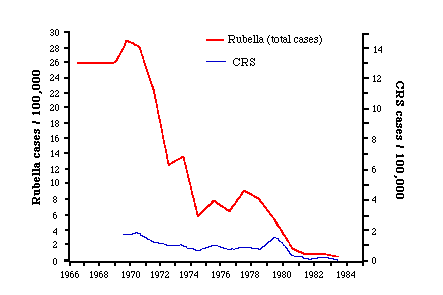Alphaviruses-
Prevention of Alphavirus outbreaks is accomplished primarily through limitation of vector populations. Massive insecticidal campaigns are launched in areas where reservoirs of disease are suspected. The most common method of eliminating vector populations is through the application of lavrvicaidal chemicals to vector breeding areas. Although very effective, many environmentalists are appalled at the practice of dumping toxins into our water supplies. Aerial campaigns against adult vectors are are not normally launched, but aerosols including malathion (also used in the California Bay Area in the 80s to prevent the establishment of fruit-fly colonies in California) and pyrethrins have been used as an emergency control when epidemic Alphavirus is imminent.
Vaccination
Virus population is also limited through vaccination. The incidence of alphavirus infection in man does not warrant systematic vaccination of human populations, but the incidence of infection in animals, especially horses, is high enough to call for animal vaccination. Because arboviruses ar often harbored and amplified by horses, equine vaccinations for EEEV, WEEV, and VEEV have been developed and are used throughout the united states.
Humans at high risk, including veterinarians, zoo keepers, and others who are in close proximity with animal reservoirs of alphaviruses are encouraged to be vaccinated against the encephalitic arboviruses. Inactivated vaccine is available for EEV, WEEV, and VEEV. A live attenuated vaccine is also available for VEEV. Because Chikunga virus has the potential to be transferred to mosquito strains indigenous to the Americas, CHIKV vaccines are under development.
Vaccination

- From Centers for Disease Control: Rubella and Congenital Rubella Syndrome MMWR 43(21):397:397, 1994.
Rubella, once thought to be simply one of the mild diseases of man took on great importance to the medical community when, in 1941, it was associated with a number of birth defects. In 1969, an effective live attenuated vaccine was developed for Rubella, and in 1972 it was comined with Measles and Mumps vaccines to become the now famous MMR vaccine. It was then reccomended that all children be inoculated at 15 months of age, to reduce the host population and the chance of primary infection during pregnancy. The reemergence of measles in the late 80s, spurred a new reccomendation to revaccinate those entering kindergarden or junior high school was put in place. Following the implementation of the universal vaccination, the incidence of congenital Rubella syndrome (CRS) in the United States was reduced to 0 cases per 100,000. The remaining cases of CRS are atributable to failure to vaccinate rather than failure of vaccine.